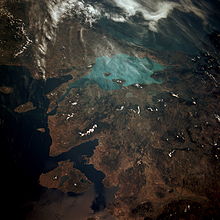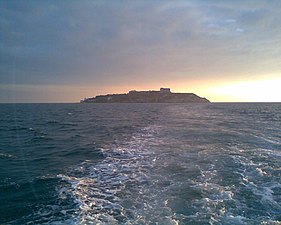Sea of Marmara

Multi tool use
| Sea of Marmara Marmara Denizi | |
|---|---|
 Map of the Sea of Marmara | |
| Location | Europe and Asia |
| Coordinates | 40°41′12″N 28°19′7″E / 40.68667°N 28.31861°E / 40.68667; 28.31861Coordinates: 40°41′12″N 28°19′7″E / 40.68667°N 28.31861°E / 40.68667; 28.31861 |
| Type | Inland Sea |
| Primary inflows | Simav River, Biga Çayı, Nilüfer River |
| Primary outflows | Turkish Straits |
| Catchment area | 11,500 km2 (4,400 sq mi) |
Basin countries | Turkey |
| Surface area | 11,350 km2 (4,380 sq mi) |
| Average depth | 494 m (1,621 ft) |
| Max. depth | 1,370 m (4,490 ft) |
| Water volume | 3,378 km3 (810 cu mi) |
| Islands | Marmara Island, Avşa, İmralı, Prince Islands, Paşalimanı and Ekinlik Island |
| Settlements | Istanbul, Bursa, İzmit, Tekirdağ, Balıkesir, Çanakkale, and Yalova |

Photograph of the Sea of Marmara from space (STS-40, 1991). The sea is the light-colored body of water.

This astronaut photograph highlights the metropolitan area of Izmit along the northern and eastern shores of the Sea of Marmara, at the end of the Gulf of Izmit.

Sea of Marmara – From the dining room of the Rákóczi exile
The Sea of Marmara (/ˈmɑːrmərə/; Turkish: Marmara Denizi), also known as the Sea of Marmora or the Marmara Sea, and in the context of classical antiquity as the Propontis is the inland sea, entirely within the borders of Turkey, that connects the Black Sea to the Aegean Sea, thus separating Turkey's Asian and European parts. The Bosphorus strait connects it to the Black Sea and the Dardanelles strait to the Aegean Sea. The former also separates Istanbul into its Asian and European sides. The Sea of Marmara is the smallest sea in the world. It has an area of 11,350 km2 (4,380 sq mi), with dimensions 280 km × 80 km (174 mi × 50 mi).[1]Its greatest depth is 1,370 m (4,490 ft).
Contents
1 Name
2 Geography
2.1 Extent
3 Towns and cities
4 Image gallery
5 See also
6 References
7 External links
Name
The sea takes its name from Marmara Island, which is rich in sources of marble, from the Greek μάρμαρον (marmaron), "marble".[2]
The sea's ancient Greek name Propontis derives from pro- (before) and pontos (sea), deriving from the fact that the Greeks sailed through it to reach the Black Sea, Pontos. In Greek mythology, a storm on Propontis brought the Argonauts back to an island they had left, precipitating a battle where either Jason or Heracles killed King Cyzicus, who mistook them for his Pelasgian enemies.[3]
Geography
The surface salinity of the sea averages about 22 parts per thousand, which is slightly greater than that of the Black Sea, but only about two-thirds that of most oceans. The water is much more saline at the sea bottom, averaging salinities of around 38 parts per thousand, similar to that of the Mediterranean Sea. This high-density saline water, like that of the Black Sea, does not migrate to the surface. Water from the Susurluk, Biga (Granicus) and Gonen Rivers also reduces the salinity of the sea, though with less influence than on the Black Sea. With little land in Thrace draining southward, almost all of these rivers flow from Anatolia.
The sea contains the archipelago of the Prince Islands and Marmara Island, Avşa and Paşalimanı.
The south coast of the sea is heavily indented, and includes the Gulf of İzmit (Turkish: İzmit Körfezi), the Gulf of Gemlik (Turkish: Gemlik Körfezi), Gulf of Bandırma (Turkish: Bandırma Körfezi) and the Gulf of Erdek (Turkish: Erdek Körfezi). During a storm on December 29, 1999, the Russian oil tanker Volgoneft broke in two in the Sea of Marmara, and more than 1,500 tonnes of oil were spilled into the water.
The North Anatolian Fault, which has triggered many major earthquakes in recent years, such as the August and November 1999 earthquakes in Izmit and Düzce, respectively, runs under the sea.
Extent
The International Hydrographic Organization defines the limits of the Sea of Marmara as follows:[4]
On the West. The Dardanelles limit of the Aegean Sea [A line joining Kum Kale (26°11'E) and Cape Helles].
On the Northeast. A line joining Cape Rumili with Cape Anatoli (41°13'N).
Towns and cities
Towns and cities on the Marmara Sea coast include:
Istanbul Province
| Balıkesir Province
Bursa Province
Çanakkale Province
| Kocaeli Province
Tekirdağ Province
| Yalova Province
|
Image gallery

Aerial view of the Bosphorus, southern end and Istanbul in the background
View of Marmara Sea from Istanbul (Kumkapı)

Sea of Marmara approaching Yassıada

View of the Marmara Sea from Yeşilköy

View of the Marmara Sea from Kadıköy
See also
- 1509 Constantinople earthquake
- 1999 İzmit earthquake
- Black Sea deluge hypothesis
- Kanal İstanbul
- Montreux Convention Regarding the Regime of the Straits
- Turkish Straits
References
^ "Marmara, Sea of - Dictionary definition of Marmara, Sea of - Encyclopedia.com: FREE online dictionary". www.encyclopedia.com. Retrieved 3 January 2018..mw-parser-output cite.citationfont-style:inherit.mw-parser-output qquotes:"""""""'""'".mw-parser-output code.cs1-codecolor:inherit;background:inherit;border:inherit;padding:inherit.mw-parser-output .cs1-lock-free abackground:url("//upload.wikimedia.org/wikipedia/commons/thumb/6/65/Lock-green.svg/9px-Lock-green.svg.png")no-repeat;background-position:right .1em center.mw-parser-output .cs1-lock-limited a,.mw-parser-output .cs1-lock-registration abackground:url("//upload.wikimedia.org/wikipedia/commons/thumb/d/d6/Lock-gray-alt-2.svg/9px-Lock-gray-alt-2.svg.png")no-repeat;background-position:right .1em center.mw-parser-output .cs1-lock-subscription abackground:url("//upload.wikimedia.org/wikipedia/commons/thumb/a/aa/Lock-red-alt-2.svg/9px-Lock-red-alt-2.svg.png")no-repeat;background-position:right .1em center.mw-parser-output .cs1-subscription,.mw-parser-output .cs1-registrationcolor:#555.mw-parser-output .cs1-subscription span,.mw-parser-output .cs1-registration spanborder-bottom:1px dotted;cursor:help.mw-parser-output .cs1-hidden-errordisplay:none;font-size:100%.mw-parser-output .cs1-visible-errorfont-size:100%.mw-parser-output .cs1-subscription,.mw-parser-output .cs1-registration,.mw-parser-output .cs1-formatfont-size:95%.mw-parser-output .cs1-kern-left,.mw-parser-output .cs1-kern-wl-leftpadding-left:0.2em.mw-parser-output .cs1-kern-right,.mw-parser-output .cs1-kern-wl-rightpadding-right:0.2em
^ Liddell, Henry George; Scott, Robert. "A Greek-English Lexicon". Henry Stuart Jones and Roderick McKenzie. Perseus. Retrieved January 12, 2009.
^ Parada, Carlos. "Greek Mythology Link". Archived from the original on February 13, 2002. Retrieved April 30, 2001.
^ "Limits of Oceans and Seas" (PDF) (3rd ed.). International Hydrographic Organization. 1953. Retrieved February 7, 2010.
External links
 Media related to Sea of Marmara at Wikimedia Commons
Media related to Sea of Marmara at Wikimedia Commons- Encyclopædia Britannica
- SCIENCE FOCUS – SeaWiFS, Sea of Marmara: Where Ancient Myth and Modern Science Mix
tEn5bcfKA2mkomUDzU992NZs0smC7jFWh,lmAphDihHI96,j16un6PtW3qyH,DNoJwZvbMlvtm nyR4Vu OfwdwEB5pTP33,ap,93,qZlY




